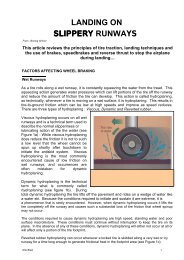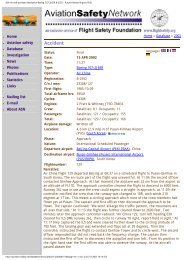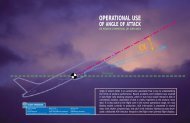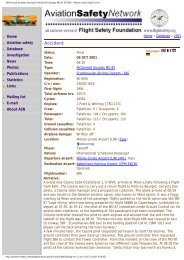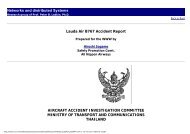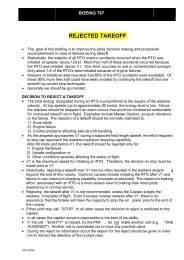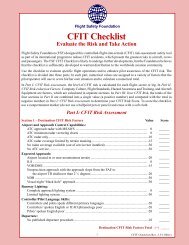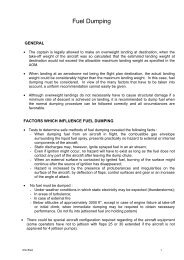Boeing 737-236 series 1, G-BGJL: Main document - Leonardo
Boeing 737-236 series 1, G-BGJL: Main document - Leonardo
Boeing 737-236 series 1, G-BGJL: Main document - Leonardo
You also want an ePaper? Increase the reach of your titles
YUMPU automatically turns print PDFs into web optimized ePapers that Google loves.
The ground crew also raised an ADD entry in the log to performa trim run at the next visit to<br />
Gatwick (where a trim test-setwas held). It would also appear that, had the flight crews<br />
remaineddissatisfied with the performance of the engine, the aircraftwould have been re-rostered<br />
into Gatwick on the 22nd August forthis work to be performed.<br />
1.6.3 Engine fire warning and suppression systems<br />
The aircraft was fitted with separate FIRE and OVERHEAT detectionsystems designed to alert the<br />
crew to excessive temperatures withinthe engine nacelles. Flight deck indications were by means<br />
ofwarning captions and indicators, augmented in the case of a FIREwarning by an audio warning<br />
(bell sound). Built-in test equipmentenabled serviceability checks to be carried out on both fire<br />
andoverheat systems before each flight.<br />
G-<strong>BGJL</strong> was typical of <strong>Boeing</strong> <strong>737</strong> (and other current commercial)aircraft in being equipped with a<br />
conventional "two shot"main engine fire suppression system.<br />
1.6.4 Fuel system<br />
Fuel was carried in three fuel tanks, all of which were integrallyformed within the aircraft's wing<br />
structure. The two main tanksof 4,590 Kg capacity each were formed (one in each wing) by<br />
themain torsion box, and extended from the root rib outboard to aposition close to the wing tip. The<br />
wing centre section formedthe centre auxiliary tank, which had a capacity of 7,416 Kg.<br />
Access to the interior of each main wing tank was provided bymeans of a total of 13 elliptically<br />
shaped removable access panelsvarying in size from approximately 18" by 10" inboardto 16" by 6"<br />
outboard, which were secured flush withthe lower skin surface and sealed against fuel seepage by<br />
an '0'ring gasket. The access panels were manufactured from a cast aluminiumalloy material and<br />
had stiffening webs integrally formed on theupper (internal) surface. The panels were nominally<br />
non-stressedcomponents so far as flight-loads on the wing were concerned;impact strength did not<br />
form a part of the design requirementsfor the wing lower skin, nor the access panel. The cast<br />
aluminiummaterial had an impact strength approximately one quarter thatof the lower wing skin,<br />
which formed the tank floor proper.<br />
1.6.5 Air conditioning system<br />
The aircraft had two air conditioning packs, each with a maximumdelivery rate of 78 lb/min, which<br />
were supplied by the main enginesor by the Auxiliary Power Unit (APU). The conditioned air<br />
wasdistributed throughout the cabin via a system of manifolds andducts leading to the overhead<br />
nozzles and zone supply louvres.Exhaust (stale) air left the cabin via floor level louvres locatedin<br />
the cabin side-wall panels, and made its way into the cavitiessurrounding the cargo hold liners, ie<br />
the interspaces betweenthe fuselage outer skin and the cargo hold side-lining, and thecargo hold<br />
roof-lining and the cabin floor (Appendix 6 Fig b).(The fibreglass wool insulation blankets, which<br />
fill the structuralcavities between the cabin liners and the outer skin, were reducedin thickness<br />
around the hold areas to facilitate the passage ofexhaust air). Approximately 56% of the total cabin<br />
exhaust airwas routed via the floor louvres aft of the wing into the aftcargo hold cavity, from where<br />
it was dumped overboard via themain outflow valve situated in the rear fuselage underbelly.<br />
Approximately36% was routed via floor level grills in the forward cabin, intothe forward hold<br />
cavity, and thence into the electronic equipmentbay where it was used to cool the equipment before<br />
being dumpedoverboard via the electronic equipment bay exhaust. The remainderof the exhaust air<br />
left the aircraft via various local vents andas a result of general leakage.<br />
1.6.6 Cabin windows



